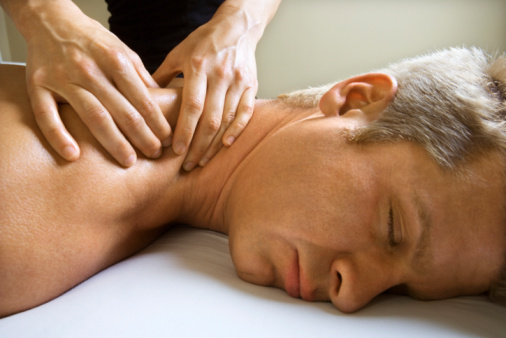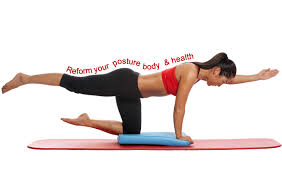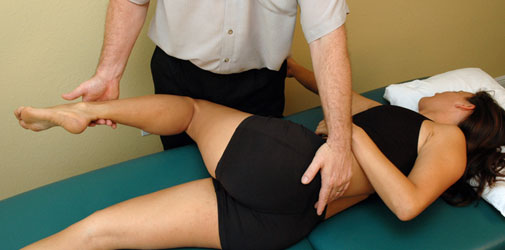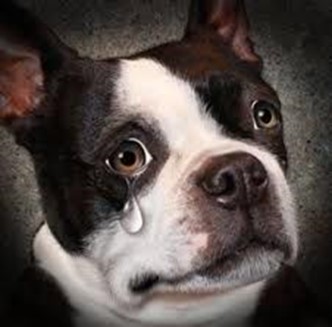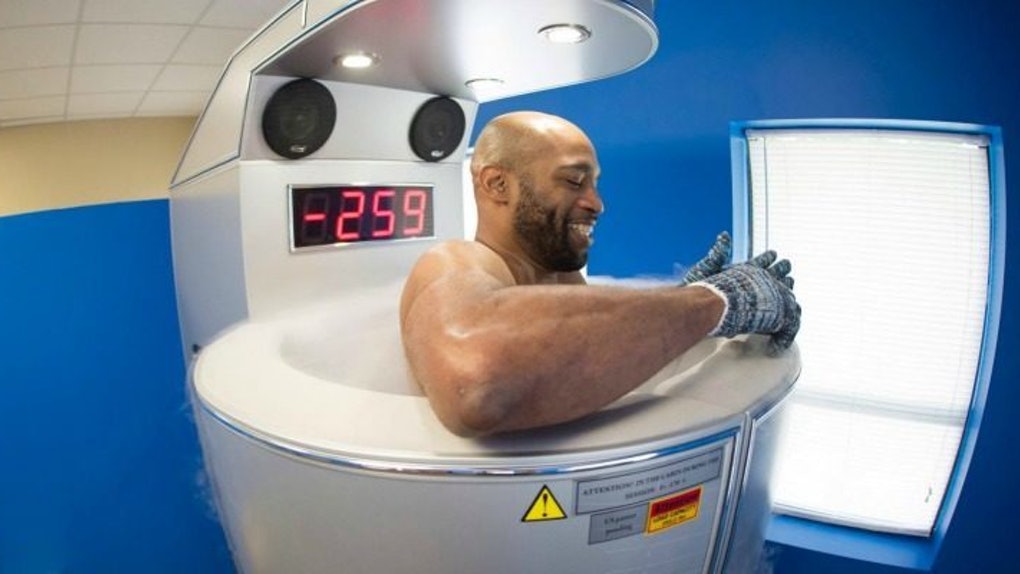
3 CEUs
Background:?While static stretch (SS), proprioceptive neuromuscular facilitation (PNF) and oscillatory physiological?mobilization techniques are documented to have positive effects on a range of motion, there are no reports on the?effect of dynamic oscillatory stretching (DOS), a technique that combines these three techniques, on hamstring?extensibility.
Purpose:?To determine whether DOS improves hamstring extensibility and stretch tolerance to a greater degree than?SS in asymptomatic young participants.
Methods:?Sixty participants (47 females, 13 males, mean age 22 ? 1 years, height 166 ? 6 centimeters, body mass 67.6 ? 9.7 kg) completed a passive straight leg (SLR) to establish hamstring extensibility and stretch tolerance as perceived by participants using a visual analogue scale (VAS). Participants were randomly assigned to one of two treatment groups (SS or DOS) or a placebo control (20 per group). Tests were repeated immediately following and one?hour after each intervention.
Results: ?Immediately post-intervention, there was a significant improvement in the hamstring extensibility as measured by the SLR in both the SS and DOS groups, with the DOS group exhibiting a significantly greater increase than the SS group. ?One hour post-intervention, hamstring extensibility in the DOS group remained elevated, while the SS group no longer differed from the control group. Furthermore, the stretch tolerance remained significantly elevated for the SS group, but there was no difference between the control and DOS groups.
Conclusion:?DOS was more effective than SS at achieving an immediate increase in hamstring extensibility, and DOS demonstrated an increased stretch tolerance one-hour post-intervention.
read more

3 CEUs
The science of sports injury prevention has grown exponentially over the past two decades. We know that interventions can prevent major knee, ankle and other injuries.
This course will help you to help your sports clients to reduce the risk of injury. You will gain a thorough?understanding of how sports injuries occur. Then you will gain in-depth knowledge of the factors that can reduce the risk of injury ? warm-up, stretching, taping and bracing, equipment, surfaces, training, envelope of function and the central governor?model for the limit of performance and their appropriate use.? ? ? ? ? ? ? ? ? ? ? ? ? ? ? ? ? ? ? ? ? ? ? ? ? ? ? ? ? ? ? ? ? ? ? ? ?
read more

3 CEUs
The science of sports injury prevention has grown exponentially over the past two decades. We know that interventions can prevent major knee, ankle and other injuries. This course will help you to help your sports clients to reduce the risk of injury. You will gain a thorough?understanding of how sports injuries occur. Then you will gain in-depth knowledge of the factors that can reduce the risk of injury ? warm-up, stretching, taping and bracing, equipment, surfaces, training, envelope of function and the central governor?model for the limit of performance and their appropriate use.
read more
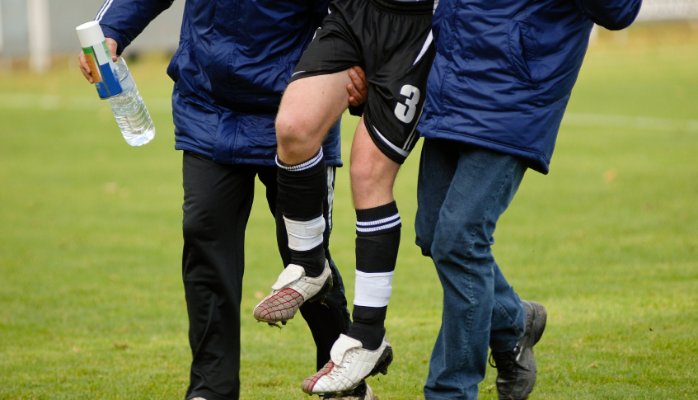
3 CEUs
The science of sports injury prevention has grown exponentially?over the past two decades. We know that interventions can prevent major knee, ankle and other injuries. This course will help you to help your sports clients to reduce the risk of injury. You will gain a thorough understanding of how sports injuries occur. Then you will gain in-depth knowledge of the factors that can reduce the risk of injury ? warm-up, stretching, taping and bracing, equipment, surfaces, training, envelope of function and the central governor model for the limit of performance and their appropriate use.? ? ? ? ? ? ? ? ? ? ? ? ? ? ? ? ? ? ? ? ? ? ? ? ? ? ? ? ? ? ? ? ? ? ? ?
read more

3 CEUs
The science of sports injury prevention has grown exponentially over the past two decades. We know that interventions can prevent major knee, ankle and other injuries. This course will help you to help your sports clients to reduce the risk of injury. You will gain a thorough understanding of how sports injuries occur. Then you will gain in-depth knowledge of the factors that can reduce the risk of injury ? warm-up, stretching, taping and bracing, equipment, surfaces, training, envelope of function and the central governor model for the limit of performance and their appropriate use.
read more

3 CEUs
This e-Learning course summarises the tendinopathy continuum and articulates the authors' clinical reasoning and hands-on experience managing Achilles tendinopathy. We outline graded loading concepts while emphasising that relying on recipes is likely to fail. We also provide a perspective on the role of central pain processing and peripheral input from nociceptive fibres in the context of tendinopathy.
Rehabilitation should be tailored to address identified impairments (muscle bulk asymmetries, kinetic chain dysfunction, tolerance of energy storage and release in the Achilles tendon), and progressively work toward movements and activities relevant for the individual's sport or daily activities.
read more

3 CEUs
Static Stretch (SS) does not appear to reduce injury risk?and any effect on earlier return to sport is of marginal?clinical significance.? In contrast, a graduated strength?training programme appears to significantly reduce injury?risk and significantly reduce the time to return to sport?after injury.
Therefore, the only area in which SS might seem to offer a?specific advantage is in the area of increasing flexibility. ?However, there remains a lack of evidence that gains are?superior to those of a strength training programme. Even if?strength training is eventually confirmed as being inferior to SS at increasing flexibility, the fact that strength training improves performance, pain, disability, injury and return to sport rates mean strength training must be a mainstay of athletic development and training, in contrast to SS.
read more

3 CEUs
Increase your success rate in treating patients with anterior knee pain.
AKP can be one of the most difficult conditions to manage. The success rate of most treatment regimens has been poor and the condition frequently recurs.?
This three-part, online course will equip you with the latest tools to deal effectively with this and other related sports injuries.
You?ll learn about assessing the knee in part one; part two will introduce you to?the new integrated treatment approach; and part three deals with patellar?tendinopathy.
read more

3 CEUs
Increase your success rate in treating patients with anterior knee pain.
AKP can be one of the most difficult conditions to manage. The success rate of?most treatment regimens has been poor and the condition frequently recurs.
This three-part, online course will equip you with the latest tools to deal?effectively with this and other related sports injuries.
You?ll learn about assessing the knee in part one; part two will introduce you to?the new integrated treatment approach; and part three deals with patellar?tendinopathy.
read more

3 CEUs
Increase your success rate in treating patients with anterior knee pain.
AKP can be one of the most difficult conditions to manage. The success rate of?most treatment regimens has been poor and the condition frequently recurs.
This three-part, online course will equip you with the latest tools to deal?effectively with this and other related sports injuries.
You?ll learn about assessing the knee in part one; part two will introduce you to?the new integrated treatment approach; and part three deals with patellar?tendinopathy.
?
read more

3 CEUs
As anterior cruciate ligament (ACL) reconstruction has evolved to less invasive, more anatomical approaches, rehabilitation of the injured athlete has become more progressive and innovative.
This correspondence course will help you become familiar with these innovations, looking at everything from planning rehabilitation timetables to re-establishing the athlete?s confidence and self-efficacy; and preparing patients for return to play ? which is, after all, what we all want to achieve.
read more

3 CEUs
As anterior cruciate ligament (ACL) reconstruction has evolved to less invasive, more anatomical approaches, rehabilitation of the injured athlete has become more progressive and innovative.
This correspondence course will help you become familiar with these innovations, looking at everything from planning rehabilitation timetables to re-establishing the athlete?s confidence and self-efficacy; and preparing patients for return to play ? which is, after all, what we all want to achieve.
read more

3 CEUs
What is said to be the most common sport injury?? Which of the many different sports injuries is most likely to recur?? Answer: Ankle injuries.?
Is there anything you can do to reduce the pain, improve the function?and prevent recurrence of a sprained ankle ? or should you just tell your patient?to let the natural recovery process take its course?? This two part course provides valuable answers to these important questions.
read more

3 CEUs
What is said to be the most common sport injury? Which of the many different sports injuries is most likely to recur? Answer: Ankle injuries.
Is there anything you can do to reduce the pain, improve the function?and prevent recurrence of a sprained ankle or should you just tell your patient to let the natural recovery process take its course? This two part course provides valuable answers to these important questions.
read more

3 CEUs
- the functional anatomy of the shoulder complex;
- the key features of the clinical history;
- how to conduct a swift and effective physical examination;
- investigations;
- treatment of important shoulder conditions; and
- the prescription for practical shoulder rehabilitation.
In recent years, there have been many advances in the assessment and treatment of shoulder pain. Part one of these on-line courses reviews:
Part 2 focuses on mechanism of injury, assessment and rehabilitation of the rotator cuff.
read more

3 CEUs
- the functional anatomy of the shoulder complex;
- the key features of the clinical history;
- how to conduct a swift and effective physical examination;
- investigations;
- treatment of important shoulder conditions; and
- the prescription for practical shoulder rehabilitation.
In recent years, there have been many advances in the assessment and treatment of shoulder pain. Part one of these on-line courses reviews:
Part 2 focuses on mechanism of injury, assessment and rehabilitation of the rotator cuff.
read more

3 CEUs
These courses are based on the physiology and biomechanics of the shoulder. They provide very effective rehabilitation protocols in terms of return to play. They will assist you to diagnose not only local anatomical lesions, such as rotator cuff tear or Bankart lesion, but also the biomechanical deficits that exist in the shoulder girdle and spine.?
But that?s not all. Distant disorders such as inflexibilities of hip rotation, short hamstrings, or the stiff back also often contribute to shoulder abnormalities. The course will enable you to make a complete diagnosis and to look beyond the injured tissues to tissues that may be overloaded.?
You will also learn to detect functional biomechanical deficits as well as the subclinical adaptations that sports people use to try to maintain performance.
read more

3 CEUs
These courses are based on the physiology and biomechanics of the shoulder. They provide very effective rehabilitation protocols in terms of return to play. They will assist you to diagnose not only local anatomical lesions, such as rotator cuff tear or Bankart lesion, but also the biomechanical deficits that exist in the shoulder girdle and spine.
But that?s not all. Distant disorders such as inflexibilities of hip rotation, short hamstrings, or the stiff back also often contribute to shoulder abnormalities. The course will enable you to make a complete diagnosis and to look beyond the injured tissues to tissues that may be overloaded.
You will also learn to detect functional biomechanical deficits as well as the subclinical adaptations that sports people use to try to maintain performance.
read more

3 CEUs
Until recently, the hip joint was not thought to be a significant cause of problems in the athletic population. Now, thanks to MRI, and hip arthroscopy we have been able to learn more about some of the common underlying causes of groin pain. These will be covered in part one and two of this course.
Part 3 covers the clinical assessment and treatment of labral tears, ligamentum teres tears, synovitis, chondropathy, surgical management, os acetabulare and lateral hip pain.
This on-line course includes ample photos of exercises for hip rehabilitation.
?
read more

3 CEUs
Until recently, the hip joint was not thought to be a significant cause of problems in the athletic population. Now, thanks to MRI, and hip arthroscopy we have been able to learn more about some of the common underlying causes of groin pain. These will be covered in part one and two of this course.
Part 3 covers the clinical assessment and treatment of labral tears, ligamentum teres tears, synovitis, chondropathy, surgical management, os acetabulare and lateral hip pain.
This on-line course includes ample photos of exercises for hip rehabilitation.
read more

3 CEUs
Until recently, the hip joint was not thought to be a significant cause of problems in the athletic population. Now, thanks to MRI, and hip arthroscopy we have been able to learn more about some of the common underlying causes of groin pain. These will be covered in part one and two of this course.
Part 3 covers the clinical assessment and treatment of labral tears, ligamentum teres tears, synovitis, chondropathy, surgical management, os acetabulare and lateral hip pain.
This on-line course includes ample photos of exercises for hip rehabilitation.
read more

3 CEUs
There has been growing concern locally and internationally about the incidence of sport-related concussion and potential health ramifications for athletes. If managed appropriately most symptoms and signs of concussion resolve spontaneously, however complications can occur including prolonged duration of symptoms and increased susceptibility to further injury. There is also growing concern about potential long-term consequences of multiple concussions.?
This course will provide you with information regarding the timely recognition and appropriate management of sport-related concussion. It will also provide you with clear, unequivocal and reliable information to be readily accessible to all members of the community.
This Position Statement on Concussion in Sport brings together the most contemporary evidence-based information and presents it in a format that is appropriate for all stakeholders. This e-Learning course seeks to ensure that all members of the public have rapid access to information to increase their understanding of sport-related concussion and to assist in the delivery of best practice medical care.
read more

3 CEUs
There has been growing concern locally and internationally about the incidence of sport-related concussion and potential health ramifications for athletes. If managed appropriately most symptoms and signs of concussion resolve spontaneously, however complications can occur including prolonged duration of symptoms and increased susceptibility to further injury. There is also growing concern about potential long-term consequences of multiple concussions.??
This course will provide you with information regarding the timely recognition and appropriate management of sport-related concussion. It will also provide you with clear, unequivocal and reliable information to be readily accessible to all members of the community.?
This Position Statement on Concussion in Sport brings together the most contemporary evidence-based information and presents it in a format that is appropriate for all stakeholders. This e-Learning course seeks to ensure that all members of the public have rapid access to information to increase their understanding of sport-related concussion and to assist in the delivery of best practice medical care.
?
read more


